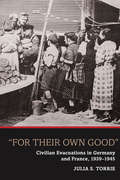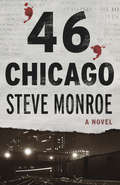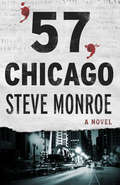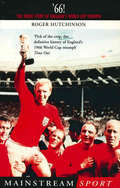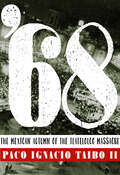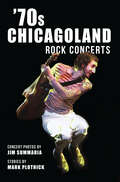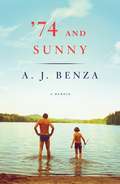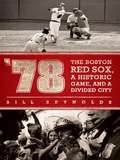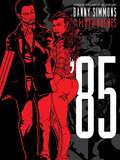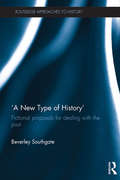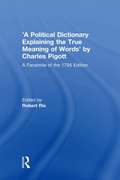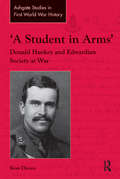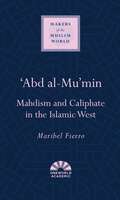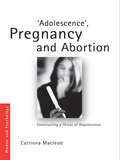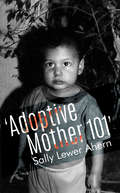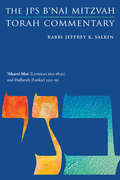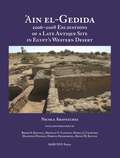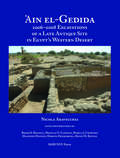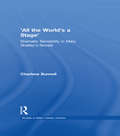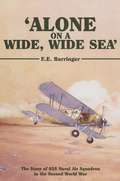- Table View
- List View
''For Their Own Good''
by Julia S. TorrieThe early twentieth-century advent of aerial bombing made successful evacuations essential to any war effort, but ordinary people resented them deeply. Based on extensive archival research in Germany and France, this is the first broad, comparative study of civilian evacuations in Germany and France during World War II. The evidence uncovered exposes the complexities of an assumed monolithic and all-powerful Nazi state by showing that citizens' objections to evacuations, which were rooted in family concerns, forced changes in policy. Drawing attention to the interaction between the Germans and French throughout World War II, this book shows how policies in each country were shaped by events in the other. A truly cross-national comparison in a field dominated by accounts of one country or the other, this book provides a unique historical context for addressing current concerns about the impact of air raids and military occupations on civilians.
'46, Chicago
by Steve MonroeDateline Chicago, 1946: Policy, the illegal lottery, makes millions of dollars for racketeers in Chicago's black community. But the numbers don't add up when kingpin Ed Jones is kidnapped. Who grabbed him? The mob? Another policy wheel operator? And why? Gus Carson, World War II veteran, a survivor of the sinking of his ship in the Pacific. A Chicago cop, he's suspended for a late night shooting at a brothel. Enter wealthy politico Arvis Hypoole. He hires Gus to find Jones. The caveat: He's got one week to do it. The challenge: Everyone's looking for Jones and most don't want to find him alive. Author Steve Monroe offers another slice of underworld life told through fact-based fiction. And his protagonist, Carson, is the conduit to the intrigue. Haunted and violent, he staves off pressure with a wisecrack or a hard cross to the jaw. He navigates through a world of gambling, nightlife, shady politics and murder, all the while seeking much more than the kidnapping victim. He's seeking redemption. And there is only one time and one city in which he can find it: '46, Chicago.
'57, Chicago
by Steve MonroeA slice of underworld life, '57, Chicago is a fact-based fictional thriller. The banker's dead--a mob killing with repercussions. Money's tied up. Three men are on a collision course: Al. He's a layoff bookie, thinks he can live as a middleman between his customers and the Outfit. His credo: Never take a position. The Lip. Desperate and dangerous, he's a fight promoter trying to create the fight of a lifetime. The Hammer. A great black hope. He's a boxer, thrust into an uncomfortable limelight. A potential heavyweight champ, his biggest fight is with himself. The cops swarm. The gangsters rage. One night. One fight. No way they can all win. The heat's intense, the stakes are high and the outcome's impossible to predict. The mystery: Who makes it out alive? It's a bloody, savage night in '57, Chicago.
'66: The Inside Story of England's 1966 World Cup Triumph
by Roger Hutchinson'. . . it is now!' With these legendary three words the 1966 World Cup final came to an end. England had won, and at 5.15 p.m. on 30 July 1966, Bobby Moore wiped his hands on his shorts, shook hands with the Queen, and took delivery of the Jules Rimet trophy before a worldwide television audience of 600 million. It was, and remains, the single greatest British sporting achievement. Alf Ramsey had taken a national team whose fortunes and confidence were at their lowest ebb, and made them World Champions. In doing so he was accused of changing the face of soccer, of turning a 'noble game' into a sport which was dominated by fitness, defences and the training park. Ramsey's 'wingless wonders', it was said, 'put football back 100 years.' How far did he and his squad set out to win sport's greatest trophy by any means possible, and how much did accident and circumstance dictate their victory? How good were Ramsey's England? Award-winning sportswriter and historian Roger Hutchinson tells a story which sparkles with wit and with sporting brilliance. '66 is the story of the greatest sporting tournament ever to take place in Britain, one that marked the birth of the modern game. It is the story of a sporting adventure which, far from putting football back 100 years, catapulted it unwillingly into the future. It is a tragedy told with a smile on its face. It is a tale that no sports fan will want to miss.
'68
by Paco Ignacio Taibo II Donald Nicholson-SmithOn the night of October 2, 1968, there occurred a bloody showdown between student demonstrators and the Mexican government in Tlatelolco Square. At least two hundred students were shot dead and many more were detained. Then the bodies were trucked out, the cobblestones were washed clean. Detainees were held without recourse until 1971. Official denial of the killing continues even today: In the first week of February 2003, Mexico's Education Secretary Reyes Tamiz ordered a new history textbook that mentions the massacre-Claudia Sierra's History of Mexico: An Analytical Approach-removed from shelves and classrooms. (Public outcry led Tamiz to reverse his decision days later.) No one has yet been held accountable for the official acts of savagery. With provocative, anecdotal, and analytical prose, Taibo claims for history "one more of the many unredeemed and sleepless ghosts that live in our lands."
'70s Chicagoland Rock Concerts
by Mark Plotnick Jim SummariaA Portal to Rock 'N' Roll History During the 1970s, Chicagoland venues hosted an eclectic mix of legendary rock 'n' roll acts that thrilled audiences. Fans flocked to historic venues like the Auditorium Theater, International Amphitheatre, Arie Crown Theatre, Kinetic Playground and B'Ginnings to forge relationships and hear music that shaped their youth and endured a lifetime. Acts like Led Zeppelin, the Who, Rolling Stones, Black Sabbath, Wings, Genesis and so many others took the stage here during rock's most prolific and memorable era. Jim Summaria and Mark Plotnick bring those mind-blowing performances back to life with exclusive concert photos, histories, trivia and more.
'74 and Sunny
by A. J. BenzaA surprisingly tender coming-of-age story of a close-knit yet tough Sicilian-American family that accepts and welcomes a young boy struggling to understand himself--by the former Daily News (New York) gossip columnist and E! television host.A.J. Benza's distinctive blend of wit, dry humor, and genuine tenderness shines through this candid, compelling memoir about the summer of 1974 when his shy, effeminate cousin comes to live with A.J.'s family, which is dominated by his short-tempered, outspoken, hyper-masculine father. At its core, A.J.'s story is about learning that "being exactly who you were meant to be is the only thing that matters." Through anecdotes of fishing with his father, playing tackle football, and conquering neighborhood bullies, he tells a story of triumph and acceptance, of a loving but rough around the edges family that puts aside its prejudices to welcome with open arms a young boy struggling to understand his sexuality and ultimately accept himself. In a sometimes raw and always endearing voice, '74 and Sunny is a revelatory account of a life-defining summer on Long Island, when tolerance wins over ignorance, family neutralizes fear, and love triumphs over all. For anyone who's navigated the choppy seas of adolescence, this story about redefining what it means to be a man, and learning to accept those whom we might fail to understand will surely resonate.
'78: The Boston Red Sox, A Historic Game, and a Divided City
by Bill ReynoldsNow in paperback: the inside story behind a crucial chapter in Red Sox lore-and a turbulent time in a troubled city. George Steinbrenner called it the greatest game in the history of American sports. On a bright October day in 1978, the Boston Red Sox met the New York Yankees for an epic playoff game that would send one team to the World Series-and render the other cursed for almost a quarter of a century. Award-winning sports columnist Bill Reynolds masterfully tells the dramatic story of the rival teams and players at this pivotal moment, and explores the social issues that divided Boston that summer and their influence on one game beyond the realm of sports.
'85
by Danny Simmons Floyd HughesInspired by the widely praised novel Three Days as the Crow Flies, Danny Simmons and Floyd Hughes present a richly illustrated graphic novel set in the gritty underworld of New York City circa 1985 -- a time and place when street culture and the fine arts scene came together in strange and often predatory ways. Crow, a junky and the son of a deceased police officer, steals a few paintings from his friend Danny, which he hopes to sell and make a few dollars off of to pay his landlord and cop some powder. Before he knows it, he's drawn into the surreal dreamland of "do-as-you-please," a hazy, hedonistic world of sex, drugs, and cold-blooded commerce. Filled with evocative black-and-white imagery and crackling with authentic, street-smart dialogue, Simmons and Hughes capture and bring to life this haunting urban tale. <P><P> <i>Advisory: Bookshare has learned that this book offers only partial accessibility. We have kept it in the collection because it is useful for some of our members. Benetech is actively working on projects to improve accessibility issues such as these.</i>
'A Free though Conquering People': Eighteenth-Century Britain and its Empire (Variorum Collected Studies)
by P.J. MarshallThe present collection brings together a series of studies by Peter Marshall on British imperial expansion in the later 18th century. Some essays focus on the thirteen North American colonies, the West Indies, and British contact with China; those dealing specifically with India have appeared in the author's 'Trade and Conquest: Studies on the rise of British domination in India'. The majority, culminating in the four addresses on 'Britain and the World in the Eighteenth Century' delivered as President of the Royal Historical Society, deal with the processes and dynamics of empire-building and aim to bring together the history of Asia and the Atlantic. The themes investigated include the pressures that induced Britain to pursue new imperial strategies from the mid-18th century, Britain's contrasting fortunes in India and North America, and the way in which the British adjusted their conceptions of empire from one based on freedom and the domination of the seas, to one which involved the exercise of autocratic rule over millions of people and great expanses of territory.
'A Great Effusion of Blood'?
by Oren Falk Mark D. Meyerson Daniel Thiery'A great effusion of blood' was a phrase used frequently throughout medieval Europe as shorthand to describe the effects of immoderate interpersonal violence. Yet the ambiguity of this phrase poses numerous problems for modern readers and scholars in interpreting violence in medieval society and culture and its effect on medieval people. Understanding medieval violence is made even more complex by the multiplicity of views that need to be reconciled: those of modern scholars regarding the psychology and comportment of medieval people, those of the medieval persons themselves as perpetrators or victims of violence, those of medieval writers describing the acts, and those of medieval readers, the audience for these accounts. Using historical records, artistic representation, and theoretical articulation, the contributors to this volume attempt to bring together these views and fashion a comprehensive understanding of medieval conceptions of violence.Exploring the issue from both historical and literary perspectives, the contributors examine violence in a broad variety of genres, places, and times, such as the Late Antique lives of the martyrs, Islamic historiography, Anglo-Saxon poetry and Norse sagas, canon law and chronicles, English and Scottish ballads, the criminal records of fifteenth-century Spain, and more. Taken together, the essays offer fresh ways of analysing medieval violence and its representations, and bring us closer to an understanding of how it was experienced by the people who lived it.
'A Justifiable Obsession'
by Penny Bryden'A Justifiable Obsession' traces the evolution of Ontario's relationship with the federal government in the years following the Second World War. Through extensive archival research in both national and provincial sources, P.E. Bryden demonstrates that the province's successive Conservative governments played a crucial role in framing the national agenda - although this central relationship has received little attention compared to those that have been more volatile. As such, Bryden's study sheds light on an important but largely ignored chapter in Canadian political history.Bryden focuses on the politicians and strategists who guided the province through the negotiation of intergovernmental economic, social, and constitutional issues, including tax policies, the design of the new social welfare net, and efforts to patriate the constitution. Written in a lucid, engaging style that captures the spirit of the politics of postwar Canada, 'A Justifiable Obsession' is a significant contribution to our understanding of Ontario's politics and political culture.
'A New Type of History': Fictional Proposals for dealing with the Past (Routledge Approaches to History)
by Beverley SouthgateLinking fiction with history and historical theory, 'A New Type of History': Fictional Proposals for dealing with the Past focuses on a selection of nineteenth- and twentieth-century novelists – Tolstoy, Proust, John Cowper Powys, Virginia Woolf, Wyndham Lewis, Penelope Lively, and James Hamilton-Paterson – who have criticized scientifically based history and proposed alternative ways of approaching the past: more subjective and personal, colourful and imaginative, and above all ethically orientated. In this, it is argued, they have been reverting to an earlier rhetorical model for history, which is now being increasingly adopted by practising historians. This ‘new type of history’ may lack the claimed ‘objectivity’ and ‘truth’ of its immediate predecessor, but it opens the way for an ethically focused subject that may be used (in Nietzsche’s words) ‘for the purpose of life’. Providing a new take on both novelists and historiography, and ranging widely from the nineteenth century to the present day, this cross-disciplinary study will be valuable reading for all those interested in the intersection and interplay between fiction and history.
'A Political Dictionary Explaining the True Meaning of Words' by Charles Pigott: A Facsimile of the 1795 Edition
by Robert RixConsidering the fact that Charles Pigott's satirical A Political Dictionary (1795) is regularly quoted and referred to in analyses of late eighteenth-century radical culture, it is surprising that until now it has remained unavailable to readers outside of a few specialised research libraries. Until his death on the 24th of June 1794, Pigott was one of England's most prolific satirists in the decade of revolutionary unrest following the French Revolution, writing a number of pamphlets and plays of which only a small proportion have survived. Pigott finished A Political Dictionary in prison, where he served a sentence for sedition. He died before his release and the book was published posthumously. The Dictionary was a brilliant satire on the "language of Aristocracy" and combined radical politics with a high entertainment value. Indeed, part of what he wrote was considered so scurrilous that the printer left out certain lines in the printed version. Modern scholars will find Pigott's work an unrivalled resource for mapping the rhetorical landscape of political debate in the 1790s, and one that yields a unique insight into the sentiments and rhetoric of radical discourse. The text stands as a convenient handbook, providing some of the wittiest and most acidic turns on familiar satirical conventions of the time, such as the "swinish multitude" metaphor and the comparison of King George III to the mad King Nebuchadnezzar. It will be an invaluable aid to students and researchers of the period - both as a highly amusing source of illustrative quotations, and as an encyclopaedia over the central sites of ideological struggle at the time.
'A Student in Arms': Donald Hankey and Edwardian Society at War (Routledge Studies in First World War History)
by Ross DaviesDonald Hankey was a writer who saw himself as a ’student of human nature’ and peacetime Edwardian Britain as a society at war with itself. Wounded in a murderous daylight infantry charge near Ypres, Hankey began sending despatches to The Spectator from hospital in 1915. Trench life, wrote Hankey, taught that ’the gentleman’ is a type not a social class. In one calm, humane, eyewitness report after another under the byline ’A Student in Arms’, Hankey revealed how the civilian volunteers of Kitchener’s Army, many with little stake in Edwardian society, put their betters to shame nonetheless. A runaway best-seller on both sides of the Atlantic, Hankey’s prose vied in popularity with the poetry of Rupert Brooke. After he was killed on the Somme in another daylight infantry charge, Hankey joined Brooke as an international symbol of promise foregone. British propaganda backed publication in the-then neutral United States, yet at home Hankey had to dodge the censors to tell the truth as he saw it. This, the first scholarly biography, has been made possible by the recovery of Hankey papers long thought lost. Dr Davies traces the life of an Edwardian rebel from privileged birth into a banking dynasty that had owned slaves to spokesman for the ordinary man who, when put to the test of battle, proves to be not-so-ordinary. This study of Hankey’s life, writing and vast audience - military and civilian - enlarges our understanding of how throughout the English-speaking world people managed to fight or endure a war for which little had prepared them.
'Abd al-Mu'min: Mahdism and Caliphate in the Islamic West (Makers of the Muslim World)
by Maribel Fierro&‘Abd al-Mu&’min (c.1094–1163) did not establish the first caliphate in the Islamic West, but his encompassed more territory than any that had preceded it. As leader of the Almohads, a politico-religious movement grounded in an uncompromising belief in the unity of God, he unified for the first time the whole of North Africa west of Egypt, and conquered much of southern Spain. Studying every facet of &‘Abd al-Mu&’min&’s rule, from his violent repression of opposition to the flourishing of scholarship during his reign, Maribel Fierro reveals an intelligent leader and a skilled military commander who sought to build a lasting caliphate across disparate and diverse societies.
'Abd al-Rahman b. 'Amr al-Awza'i (Makers of the Muslim World)
by Steven C. Judd&‘Abd al-Rahman b. &‘Amr al-Awza&‘i (c.707–774) was Umayyad Syria&’s most influential jurist, part of a generation of scholars who began establishing the first formal structures for the preservation and dissemination of religious knowledge. Following the Abbasid revolution, they provided a point of stability in otherwise unstable times. Despite his close ties to the old regime, al-Awza&‘i continued to participate in legal and theological matters in the Abbasid era. Although his immediate impact would prove short-lived, his influence on aspects of Islamic law, particularly the laws of war, endures to this day.
'Adolescence', Pregnancy and Abortion: Constructing a Threat of Degeneration (Women and Psychology)
by Catriona I. MacleodWinner of the Rhodes University Vice-Chancellor's Book Award 2012! Winner of the 2011 Distinguished Publication Award of the Association for Women in Psychology! Why, despite evidence to the contrary, does the narrative of the negative consequences of teenage pregnancy, abortion and childbearing persist? This book argues that the negativity surrounding early reproduction is underpinned by a particular understanding of adolescence. It traces the invention of "adolescence" and the imaginary wall that the notion constructs between young people and adults. Macleod examines the entrenched status of "adolescence" within a colonialist discourse that equates development of the individual with the development of civilisation, and the consequent threat of degeneration that "adolescence" implies. Many important issues are explored, such as the invention of teenage pregnancy and abortion as a social problem; issues of race, culture and tradition in relation to teenage pregnancy; and health service provider practices, specifically in relation to managing risk. In the final chapter, an argument is made for a shift from the signifier "teenage pregnancy" to "unwanted pregnancy". Using data gathered from studies worldwide, this book highlights central issues in the global debate concerning teenage pregnancy. It is ideal for academics, and students of health psychology, women’s studies, nursing and sociology, as well as practitioners in the fields of youth and social work, medicine and counselling.
'Adoptive Mother 101'
by Sally AhernAnother woman, whose name you know, gave birth to your son. How on earth do you deal with that? How do you deal with people looking at you, and then looking at your son, and you see the moment in their eyes when it registers that you do not look like each other? Sally Lewer Ahern's memoir, 'Adoptive Mother 101', is a moving and uplifting account of the complex and emotionally gruelling odyssey of adopting her son, Carlos, from Guatemala, when he was almost three years old. It is a story of love, of creating her family through intercountry adoption. Told via a series of vignettes from the portholes of her intercountry adoption quest, 'Adoptive Mother 101' is not only about the bumpy road which is intercountry adoption, it's about clutching on to mercurial hope, clinging to vicarious dreams … and to trusting blindly and determinedly in the unpredictability of the Universe. Not only for those with an interest in intercountry adoption - it's for anyone, anywhere, who has ever had hopes and dreams.
'Aharei Mot: The JPS B'nai Mitzvah Torah Commentary (JPS Study Bible)
by Rabbi Jeffrey K. Salkin'Aharei Mot (Leviticus 16:1-18:30) and Haftarah (Ezekiel 22:1-19): The JPS B’nai Mitzvah Torah Commentary shows teens in their own language how Torah addresses the issues in their world. The conversational tone is inviting and dignified, concise and substantial, direct and informative. Each pamphlet includes a general introduction, two model divrei Torah on the weekly Torah portion, and one model davar Torah on the weekly Haftarah portion. Jewish learning—for young people and adults—will never be the same. The complete set of weekly portions is available in Rabbi Jeffrey K. Salkin’s book The JPS B’nai Mitzvah Torah Commentary (JPS, 2017).
'Ain el-Gedida: 2006-2008 Excavations of a Late Antique Site in Egypt's Western Desert (Amheida IV) (ISAW Monographs #8)
by Nicola AravecchiaThe fourth volume in the Amheida series, ‘Ain el-Gedida: 2006-2008 Excavations of a Late Antique Site in Egypt's Western Desert (Amheida IV) presents the systematic record and interpretation of the archaeological evidence from the excavations at ‘Ain el-Gedida, a fourth-century rural settlement in Egypt's Dakleh Oasis uniquely important for the study of early Egyptian Christianity and previously known only from written sources.Nicola Aravecchia (Washington University), the Deputy Field Director of NYU's Amheida Excavations, offers a history of the site and its excavations, followed by an integrated topographical and archaeological interpretation of the site and its significance for the history of Christianity in Egypt. In the second half of the volume a team of international experts presents catalogs and interpretations of the archaeological finds, including ceramics (Delphine Dixneuf, CRNS), coins (David M. Ratzan, NYU), ostraca and graffiti (Roger S. Bagnall, NYU and Dorota Dzierzbicka, University of Warsaw), small finds (Dorota Dzierzbicka, University of Warsaw), and zooarcheological remains (Pamela J. Crabtree, NYU and Douglas Campana).
'Ain el-Gedida: 2006-2008 Excavations of a Late Antique Site in Egypt's Western Desert (ISAW Monographs #8)
by Nicola AravecchiaThe fourth volume in the Amheida series, ‘Ain el-Gedida: 2006-2008 Excavations of a Late Antique Site in Egypt's Western Desert presents the systematic record and interpretation of the archaeological evidence from the excavations at ‘Ain el-Gedida, a fourth-century rural settlement in Egypt's Dakleh Oasis uniquely important for the study of early Egyptian Christianity and previously known only from written sources. <p><p>Nicola Aravecchia (Washington University), the Deputy Field Director of NYU's Amheida Excavations, offers a history of the site and its excavations, followed by an integrated topographical and archaeological interpretation of the site and its significance for the history of Christianity in Egypt. In the second half of the volume a team of international experts presents catalogs and interpretations of the archaeological finds, including ceramics (Delphine Dixneuf, CRNS), coins (David M. Ratzan, NYU), ostraca and graffiti (Roger S. Bagnall, NYU and Dorota Dzierzbicka, University of Warsaw), small finds (Dorota Dzierzbicka, University of Warsaw), and zooarcheological remains (Pamela J. Crabtree, NYU and Douglas Campana).
'All the World's a Stage': Dramatic Sensibility in Mary Shelley's Novels (Studies in Major Literary Authors)
by Charlene BunnellThis book examines the often tragic and nearly always disabling metaphor of thetheatrum mundi, world-as-stage, as it plays itself out in the characters of Mary Shelley's novels.
'Alone on a Wide, Wide Sea': The Story of 835 Naval Air Squadron in the Second World War
by E.E. BarringerThis is the story of 835 Naval Air Squadron as told by one of its surviving officers. It tells the story of the outstanding fleets of flying and the importance of the Merchant Navy in the Second World War.
'Alternative' cultures and leisure: Creating pathways for sustainable livelihoods
by Stephen L. Wearing Alan LawContemporary discourse on sustainability points to the need for substantial, if not radical, shifts in relations between productivity, environment, consumption and identities, in ways which bring or restore balance to the intersecting domains. The catchphrase of ‘sustainability’ has made its way into mainstream discourse on the heels of the ongoing global financial crisis and responses to global warming. The literature of leisure, sport and particularly tourism are replete with fine examples of ‘sustainability’, contributing to full ecology planning approaches. This book aims to stimulate debate and discussion within the leisure studies community about the roles of ‘alternative cultures’ in producing viable models of sustainable relations between work, leisure and environment. Key elements of these discussions, such as participatory democracy and deep ecology, have long been characteristic of cultural configurations loosely called ‘counter’ or ‘alternative’ to a voracious, hierarchical and unconscious modernity. However the leisure studies community has largely neglected their significance up until now. How are leisure, sustainable livelihoods and ‘alternative’ cultures connected, and what influence do they have? This book was originally published as a special issue of Annals of Leisure Research.
